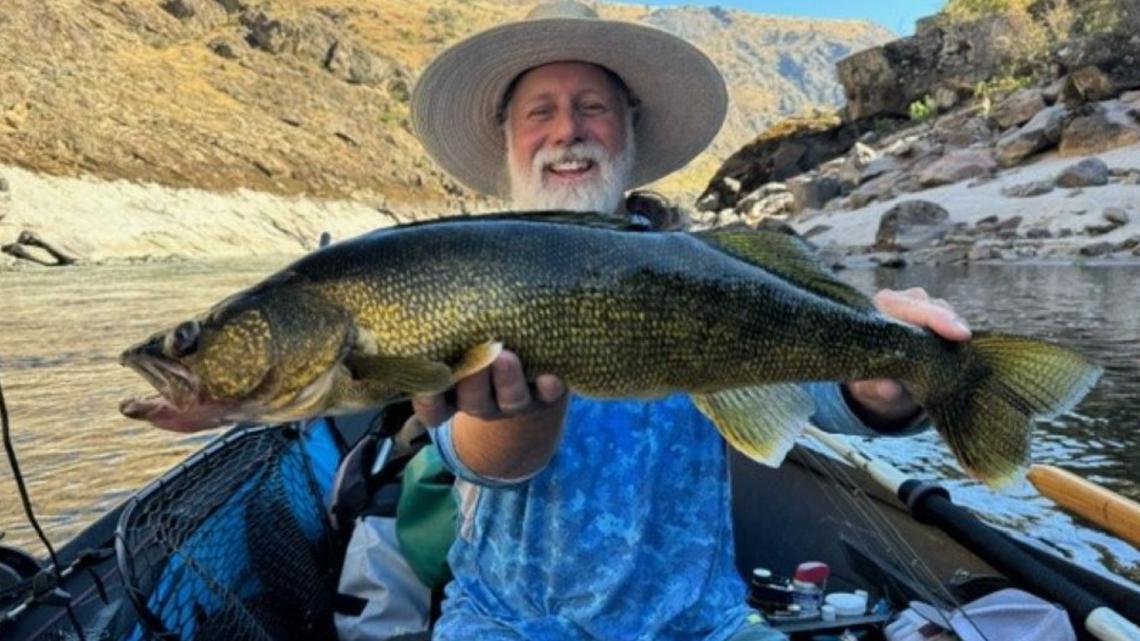
Idaho’s Department of Fish and Game says there are no limits on catching walleye that are spreading and preying on young salmon.
LEWISTON, Idaho — On Saturday, thousands of anglers will take to Minnesota lakes for the annual fishing opener.
Their sights are set on walleye, the state fish and easily the most popular, but there are statewide daily bag limits.
KARE 11’s Jennifer Hoff visited a place where walleye are all you can catch, anywhere, anytime — if you’re willing to go there.
Welcome to Lewiston, Idaho, located in the North Central region, known for being the state’s only port city and the gateway to Hells Canyon. The Snake River runs through the canyon that’s more than 100 miles long and 7,993 feet from its highest rim to the river below.
Idaho Department of Fish and Game Conservation Officer John McLain has long patrolled these parts that are particularly popular for fishing salmon and steelhead.
“Two summers ago, about 50 miles upstream, I checked a 25″ walleye that a guy had,” said McLain. “When he was holding it up, I thought it must have been a catfish because it was so big.”
Walleyes that big would make any Minnesota angler envious.
Except, the favorite fish is anything but in Idaho, as they continue to move upstream. Fish and Game is asking anyone who catches a walleye to kill it, take a photo and contact state biologist Marika Dobos.
“I think they’re big, toothy predators,” said Dobos. “There are these areas where they’re keying in on the food that’s available to them and I think that if that continues to happen, we’ll see more problems and more predation.”
Dobos says walleyes aren’t bad, they’re just wrong for Idaho, where it’s not the whitefish, but salmon, that reign supreme.
“We have spring and summer Chinook, we have fall Chinook, we have Coho, so it’s busy,” said Dobos. “That’s why we’re here and that’s why this is such a hot topic.”
Salmon have significant recreational, cultural and economic importance, bringing in a billion dollars every year. But the species is being threatened, some say, due to rising water temperatures, declining habitat and dams.
“When you have those anomalies that we can’t control, you’re taking a small population that’s already depressed and then you’re just adding more factors to it, that’s further affecting them in a negative way,” said Dobos about the salmon, that swim several local rivers to reach the Pacific Ocean and back to spawn.
Dobos says walleye are making that long, treacherous journey more difficult as they keep migrating further down river.
Anglers are catching some in Lewiston, but even more at Lower Granite Dam, which is some 60 miles away. It’s where Dobos is trapping the fish and tracking their activity.
“Up until 2016, we haven’t caught any walleye at the trap and from 2016, we’ve seen nothing but this exponential increase in walleye,” said Dobos.
The fish was never meant to be here in the first place. It was illegally introduced in Oregon by so-called “bucket biologists” about 70 years ago. The invasive species is now an apex predator that has a penchant for none other than juvenile salmon.
“They’re sitting in places where there’s a lot of food available,” said Dobos. “These are areas where these juvenile fish are rearing and just trying to survive the winter and get big enough so they can migrate out and that’s part of why we reach out to the angling community to get that support from people, to get the help from anglers and the buy-in that these are bad things and we’re going to do our part to remove them.”
Dobos is asking anglers to not release them back to the river alive and instead, enjoy a very tasty dinner.
“Part of our fear is that the folks that know about walleye and want that opportunity are going to get the word out that they’re moving into these areas and they’re going to capitalize on that,” said Dobos.
At North 40 Outfitters in Lewiston, there’s an aisle dedicated to walleye fishing gear.
“We’ve expanded it a lot in the last two years just because walleye has gotten so popular,” said former guide turned salesman John Snaza.
He has long fished for walleye and says the booming business shows no signs of stopping.
“I don’t think they’d do too much damage below Lower Granite (Dam) and that’s why I think it’d be great for them to stay,” said Snaza. “If a person wants to walleye fish, you go down there and if you want to salmon fish, you come up here, and I think that’d be perfect if we could regulate that somehow.”
Except, Dobos admits angler harvest is not an ideal tool for removing a fish species. She says the department also has a proposal to allow spear fishing in select waters to support the message that they want them removed.
Dobos and McLain are undoubtedly caught up in what has become a complicated relationship between Minnesota’s most revered fish and the salmon it’s putting at risk — whose value is as vast as the Idaho landscape they both now live in.
“The fact that we have people reporting walleye caught here, when there’s so few people up here, is pretty mind-boggling and that’s the struggle,” said Dobos.
There are three reservoirs where Fish and Game have allowed some walleye fishing. The department has been extremely selective and limits it only to Salmon Falls Creek Reservoir, Onieda Reservoir, and Oakley Reservoir.
